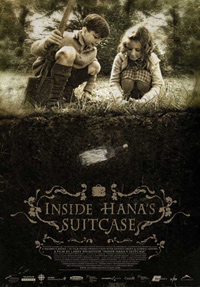Personalized Accounts From Within Auschwitz and Around The World
 There certainly is no shortage of Holocaust docs. Not to say they aren’t completely warranted, but it sometimes seems there is a never ending supply. Adding to the enormous collection of narrative proof of the despicable events that occurred at the various concentration camps throughout Europe, director Larry Weinstein has taken a momentary step away from made for TV non-fiction to tell the well known tale of Hana Brady, a Czechoslovakian Jewish girl, that was recorded in the acclaimed book Hana’s Suitcase. Pairing reenactments with the innocent storytelling of a globalized cast of enthusiastic children, as well as Hana’s own surviving brother, George, Inside Hana’s Suitcase is a highly personal story of unyielding hatred, and the unwavering empathy of adolescence.
There certainly is no shortage of Holocaust docs. Not to say they aren’t completely warranted, but it sometimes seems there is a never ending supply. Adding to the enormous collection of narrative proof of the despicable events that occurred at the various concentration camps throughout Europe, director Larry Weinstein has taken a momentary step away from made for TV non-fiction to tell the well known tale of Hana Brady, a Czechoslovakian Jewish girl, that was recorded in the acclaimed book Hana’s Suitcase. Pairing reenactments with the innocent storytelling of a globalized cast of enthusiastic children, as well as Hana’s own surviving brother, George, Inside Hana’s Suitcase is a highly personal story of unyielding hatred, and the unwavering empathy of adolescence.
After requesting a number of children’s items from Auschwitz to display at the Japanese non-profit Tokyo Holocaust Education Resource Center, the director of the facility, Fumiko Ishioka, received a suitcase that bore the name Hana Brady in white paint across its face. A powerful urge to find out who this poor girl was came over Ishioka. As time went on, she uncovered more and more about the mystery, sharing her findings with her young students, until she managed to get in contact with Hana’s brother, George, who was living in Canada. Upon hearing that others were eager to hear of his long lost sister, he traveled to Japan to meet Ishioka and her students, who greeted him with a warm welcome.
Split into two intertwined storylines, the film rides on the research process Ishioka undertook while focusing on the Brady’s grievous tale. Oddly, Weinstein chose to alternate narration between a teary-eyed George, and confident school children who’ve memorized Hana’s story. Most of the time this works wonders, as George obviously is still deeply troubled over losing his sister to such evil, and the kids can’t help but be completely genuine. This technique only fails when a child’s phrasing occasionally doesn’t capture the seriousness of a situation, making it sound almost comical. Though it lightens the mood, it breaks a tonal thread that permeates the film.
Along with the documented meeting of minds young and old, and the recounted story from talking heads, there is an abundance of reenactments that are based on major plot points, actual photographs, and Hana’s own drawings from her time in Auschwitz. Deftly shot and stylistically aged, these segments are integrated with overlapping narration that blends them seamlessly.
We are slowly nearing a time when we will no longer have Holocaust survivors among us. Documentation is essential for remembering, and avoiding such horrifying acts of pure hatred again. Thanks to filmmakers like Larry Weinstein, future generations will be able to look back, and find heartfelt accounts from people who lived through it. Hana Brady was an innocent young girl who sadly was one of over a million children murdered in Auschwitz, but her memory lives on through her loving brother, readers around the world, and now you, if you so choose.


